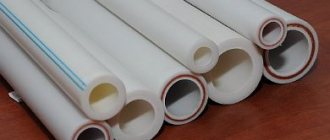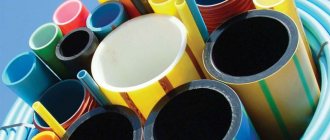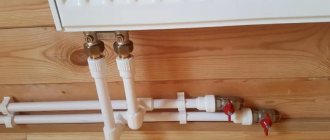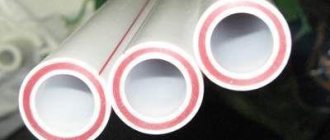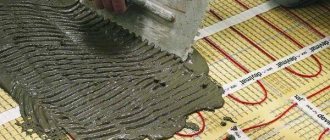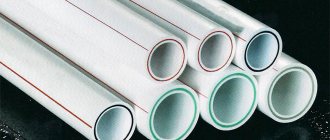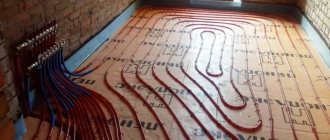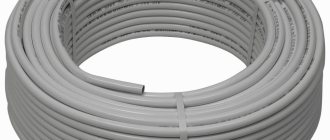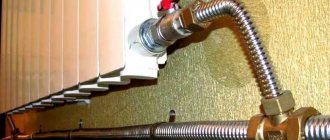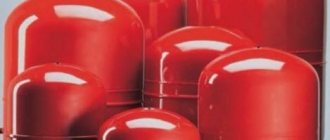Today, increasingly, plumbing and heating systems are made not from steel pipes, but from polypropylene. But this is plastic, and the question arises - what is the maximum temperature that a polypropylene pipe can withstand?
Let's look at this issue in more detail. Let's consider the properties of polypropylene material. Let's get acquainted with the types of polypropylene pipes and their characteristics. We’ll also talk about the temperatures that this pipeline can withstand, and the features of its use in hot water supply lines.
Properties of polypropylene pipes
When choosing polypropylene pipes, you should take into account those properties that significantly affect the operation of the system.
Polypropylene - has a soft structure, therefore it is not able to withstand too high temperatures, and when working under conditions of increased pressure, the service life of the pipes is significantly reduced, and the service life declared by the manufacturer of 50 years can be reduced to five, and in some cases, even to one and a half years.
And even with all its high technical indicators: ease of installation, transportation, resistance to chemical and physical influences, low thermal conductivity, etc., which make this material very popular today, we must not forget that they are not designed to work at high pressure.
In order not to make a mistake in your choice, you need to know about the marking of the nominal pressure value (PN) on the product:
- PN 10 – nominal pressure 1 MPa, temperature 45°C, single-layer pipe, intended for low-pressure cold water supply systems.
- PN 16 – nominal pressure 1.6 MPa, temperature 50°C, single-layer pipe, used for cold water supply systems and heated floors.
- PN 20 – nominal pressure 2.0 MPa, temperature 80°C, single-layer or reinforced multi-layer pipe, used for installation of individual heating and hot water supply systems.
- PN 25 – nominal pressure 2.5 MPa, temperature 95°C, reinforced multilayer pipe, used for installation of individual and centralized heating and hot water supply systems.
And yet it is obvious that, despite the loads that PPR pipes are designed for, it is better not to use them at maximum values.
We recommend that you read: Replacing old pipes with polypropylene on your own
Technical characteristics of models without reinforcement
Pipes of the PN series (without reinforcement) are made of one material - polypropylene - and have modifications PN10, PN16, PN20.
The thin-walled PN10 pipe is designed for a pressure of 10 bar. Used for installation of cold water pipelines indoors and outdoors. It is used in ventilation, as well as when transporting aggressive liquids that do not react with polypropylene. The permissible operating temperature is +45 °C. PN10 uses less material to produce, so it is cheaper than other polymer pipes.
Cold and hot water supply pipes are made from PN16 polypropylene pipes with a specified carrier temperature of +60 °C and an allowed pressure of 16 bar. Compared to PN10, PN16 has thicker walls and, accordingly, increased strength.
PN20 can withstand temperatures of +80 °C and pressure of 20 bar. Short-term heating of the media to +100 °C is allowed. Such characteristics make it possible to use it in hot water and central heating pipelines.
Distinctive qualities of the PN10 - PN20 series pipes include relatively low cost and ease of installation: there is no need to strip the pipe before soldering. According to SNiP 2.04.01-85, the pressure in domestic heating systems should not exceed 4.5 bar. Therefore, the main criterion for choosing unreinforced polypropylene pipes for heating is temperature.
Pressure and temperature - limit values
Considering that the melting point of the starting material is slightly higher than 175°C, the product quickly loses strength when heated strongly and collapses under the influence of excess pressure. Butt joints of pipelines are also very susceptible to overheating; with sudden changes in pressure, their tightness is easily broken.
Depending on their purpose, pipelines experience various physical impacts during operation. Heating fluid circulates in heating pipelines at temperatures often reaching 90°C. The operating pressure value depends on the heat supply source, building characteristics and terrain. Its value can reach 1.6 MPa or more in centralized heating systems of multi-story buildings.
Hot water supply pipelines are designed, as a rule, to supply consumers with water at a temperature of 65°C at a pressure of 0.2 to 2.0 MPa, depending on local conditions and the scheme used.
The higher the temperature of the working medium, the lower the pressure should be. With constant operation in conditions where both indicators are close to the maximum, the service life of the pipes is significantly reduced.
Note! The choice of materials and installation methods must be made taking into account the temperature and pressure parameters characteristic of the system. The use of materials that do not meet the conditions will lead to gradual destruction of the pipeline.
General information
Where are polypropylene pipes used?
Pipes made of high-quality plastic are used when laying water pipes in apartments, private houses, cottages and industrial enterprises. With their help, they organize the supply of cold and hot water, and they are also capable of transporting aggressive chemical solutions and air.
Important! Welding joints of polypropylene pipes are considered as strong as metal ones. This quality makes the material beneficial for the construction of various water supply systems.
Pros and cons of plastic pipes. Positive characteristics of polypropylene pipes:
- 1. They are not susceptible to corrosive changes or the deposition of limescale from water.
- 2.Polypropylene is absolutely non-toxic, does not emit chemicals and odors during its entire service life.
- 3.The diameter of the products does not change under any circumstances.
- 4.The product is made from environmentally friendly raw materials, which has a positive effect on the water passing through the pipes.
- 5.pipes are able to withstand high pressure and sudden changes in temperature conditions.
- 6.The smooth surface helps maintain the water pressure at the outlet.
- 7.Low level of thermal conductivity.
- 8.pipes do not form condensation on the surface.
- 9.Increased sound insulation.
- 10.Polypropylene products are opaque, so during system operation they resist the formation of algae and bacteria that are sensitive to sunlight.
- 11. At low temperatures, the structure of the pipes is not damaged; they are able to stretch if the water in them freezes. When heated, the pipes restore their size.
- 12.Installation of polypropylene elements is easy and quick.
- 13. The weight of products made from polypropylene is nine times less than similar ones made from metals.
- 14.Considered to be an economical option for plumbing. Pipes do not require additional thermal or waterproofing.
Negative characteristics of polypropylene:
- 1.high linear expansion under temperature changes.
- 2.Cannot be installed or used at very low temperatures.
- 3.unresistant to UV rays.
- 4.Easily flammable, cannot be used in highly flammable systems.
Reinforced pipes
Reinforcement helps to increase the service life of pipes, as well as make them more stable and wear-resistant.
Reinforced polypropylene pipes are a special type of multilayer pipes with a strong internal frame that reduces thermal expansion and increases the ability to operate at elevated operating temperatures and pressures.
There are several methods of pipe reinforcement:
- Reinforcement with aluminum foil (perforated or whole). Between two layers of PPR polypropylene, a layer of foil up to 0.7 mm thick is fixed with glue. The reinforcing layer is placed between the layers in the middle or closer to the surface.
- Fiberglass reinforcement. To reduce thermal expansion, fiberglass is placed in the middle between the inner outer layers of polypropylene.
We recommend that you read: What are reinforced polypropylene pipes?
Recommendations for selection
When going to the store, pay attention not only to the price, but also to the technical characteristics of the product. Select pipes with a small margin based on basic operating parameters.
- Operating pressure. Manufacturers indicate its value for room temperature, therefore, when choosing pipes for the heating system of an apartment, pay attention to PN25 brand products. If you are the owner of a home with individual heating, pipes marked PN20 will be sufficient.
- Temperature. For reinforced pipes, manufacturers indicate a coolant temperature of at least 90°C. You should not overpay for products labeled 95°C - their characteristics are the same.
- Diameter. For risers with a diameter of ¾ inches you will need a pipe with a diameter of 25 mm, and for inch risers - 32 mm. For linear wiring, 20mm products are most often used.
- For heating and hot water supply, choose only reinforced products.
When choosing pipes, remember that their manufacture is a high-tech process. Therefore, do not be tempted by the low price of Chinese products - the slightest violation of technology leads to delamination of pipes during operation. And this is fraught with big troubles.
Even products with the most impressive characteristics from a world-famous company will not be able to fully operate if the installation of the system was initially carried out carelessly and with miscalculations. Pay close attention to this when constructing pipelines from polypropylene pipes with your own hands.
remkasam.ru
What pressure can soldering plastic pipes withstand at a water temperature of 75-80 degrees?
Polypropylene pipes (PPR) can easily withstand pressures up to 10 bar. This is what they write on the official website of WAVIN EKOPLASTIK.
Before putting into operation, the water supply system is pressurized with a pressure exceeding the working pressure by 1.5 times. I have encountered leaking PPR several times. There was no critical pressure there (no more than 5 bar). Basically, the whole problem is the unpreparedness of the performers.
If the pressure switch breaks down at a 1.1 kW pumping station, what is the maximum pressure it can pump?
The pumps of automatic pumping stations are centrifugal and pump up a pressure of no more than 3.2 bar. Here is a quote from the reference book:
Centrifugal pump is a pump in which the movement of liquid and the required pressure are created due to the centrifugal force that occurs when the impeller blades act on the liquid. Inside the pump housing, which usually has a spiral shape, an impeller is rigidly fixed to the shaft.
o, as a rule, consists of rear and front disks, between which blades are installed. They are bent from the radial direction in the direction opposite to the direction of rotation of the impeller. Using pipes, the pump housing is connected to the suction and pressure pipelines. If the pump body is completely filled with liquid from the suction pipeline, then when the impeller is rotated (for example, using an electric motor), the liquid that is in the channels of the impeller (between its blades) will be thrown from the center of the impeller to the periphery under the influence of centrifugal force. This will lead to a vacuum being created in the central part of the wheel, and pressure increasing at the periphery. And if the pressure increases, the liquid from the pump will begin to flow into the pressure pipeline. As a result, a vacuum is formed inside the pump housing, under the influence of which liquid will simultaneously begin to flow into the pump from the suction pipeline. Thus, there is a continuous supply of liquid by a centrifugal pump from the suction to the pressure pipeline.
You must take into account that such pumps increase pressure. That is, if there is water pressure in the water supply system and the pump turns on, say due to an automatic failure, it will increase the pressure by another 3.2 bar.
Is it necessary to install a burst valve on a water supply system to protect plastic pipes?
A blast or emergency valve is installed on closed systems (heating). Reduction reducers are installed on the water supply system. And it is not the pipes that need to be protected, but the devices connected to them.
forumsan.ru
Features of installation of polypropylene pipes
How the pipeline will operate depends on correct installation, and, accordingly, errors during installation work can lead to an increase in pressure in the pipe.
Already at the stage of planning and purchasing materials, it is important to choose the right type of pipes depending on what pressure will be in the line; even a non-professional, without much experience in construction, will be able to figure out which pipes will suit him if he carefully studies the product labeling and selects those components that he needs.
The industry produces pipes of various types, designed to operate at different temperatures and with different pressures:
- PPH (homopolymer) – intended for low-pressure cold water supply systems, drainage and process pipelines.
- PPB (block copolymer) - used in water supply and drainage systems, for the installation of heated floors, for the manufacture of impact-resistant pipes and fittings.
- PPR (static copolymer) - used in the installation of heat supply systems.
In addition, the properties of polypropylene pipes depend on the design. To expand the scope of use, they are manufactured:
- Single-layer (have a large coefficient of linear expansion, designed for moderate temperatures and pressures).
- Multilayer (reinforced with fiberglass or foil, used in systems with high pressure and temperature values).
During installation, it is important to pay attention to the ambient temperature and when welding, do not overheat the pipe, otherwise it may change size, which can lead to leaks.
Note! It is important to pay attention to the fact that when laying a pipeline in a multi-story building, the pressure on the lower floors will be higher than on the upper ones. And although this difference is not so great, in some cases it is necessary to install special pumps to stabilize pressure indicators.
Basic physical and mechanical parameters
The Russian standard for “Thermoplastic pressure pipes and connecting parts for heating and water supply systems” (GOST 521343:2003) establishes six operating classes for polypropylene pipes depending on the nominal temperature:
- Application in hot water supply (up to 60°C).
- Application in hot water supply (up to 70°C).
- Use in underfloor heating systems (low temperature - up to 60°C).
- Work in high-temperature floor and low-temperature radiator heating systems (up to 70°C).
- Work in high-temperature radiator heating systems (up to 90°C).
- Application in cold water supply (class designation - ХВ).
Characteristics
- The density of polypropylene is the lowest of all plastics - 0.91 kg/cm2. Despite this, the surface of products made from it has high hardness and wear resistance.
- The mechanical strength of PP-R pipes depends on the time of force application, and since this parameter is associated with gradual heating or cooling, we can speak of sufficient strength for any operating conditions. By the way, the limit value for PPR is 35 N/mm.
- Increased resistance to chemically aggressive environments - surface destruction is possible only when combined with high-temperature exposure to a strong acid.
- Frost resistance – no less than -15°C. Most often, pipes work with coolant at positive temperatures, so even such unexceptional indicators are quite enough.
- The melting point of polypropylene is from 160 to 170°C, depending on the composition.
- Softening point - 140°C.
- The maximum coolant temperature is no more than 120°C.
- Working pressure – from 10 to 25 atmospheres.
- External diameter – from 16 to 125mm.
The bending radius of pipes depends both on their diameter and on the presence and type of reinforcing layer. The maximum parameter is for polypropylene pipes with aluminum reinforcement without perforation.
Markings and sizes
Labeling of polypropylene products can include both information about the material and data on nominal pressure and temperature. The letter index means:
- PP – simple polypropylene.
- PP-R – polypropylene random copolymer.
- PP-RC is a random copolymer of type III polypropylene, intended for hot water supply and heating systems.
- PP-RCT is an improved random copolymer of polypropylene.
PP-RC pipes are precisely those products that are used in water supply and heating systems. They are most often used in industry and agriculture.
The letter designation of pipes is PN, and there are four product modifications, depending on the nominal operating pressure for which they are designed:
- PN10 – liquid pressure up to 10 atmospheres. PN10 pipes are used for transporting low-temperature coolant (up to 45°C) in cold water supply or underfloor heating systems.
- PN16 – the allowed pressure in the system is no more than 16 atmospheres, and the operating temperature should not exceed 60°C. Recommended for use in low-temperature heating systems.
- PN20 is the most common brand. Allows transportation of liquid up to 95°C at a pressure of up to 20 atmospheres, due to which it is used both in heating systems and in hot water supply pipelines.
- PN25 – has the lowest coefficient of linear deformation, withstands long-term liquid pressure of up to 25 atmospheres at temperatures up to 95°C.
PN pipes can be either glass fiber reinforced or aluminum foil reinforced. In the second option, it is possible to use both perforated and monolithic tape as a reinforcing layer. In heating systems, it is recommended to install pipes without foil perforation. Such products most successfully resist air diffusion into the coolant.
In everyday life, pipes with an outer diameter of 20, 25, 32, 40 mm are most often used. The main parameters of pipes of the most common brand PN20 are summarized in the table.
Manufacturers and assortment
Many large companies around the world are engaged in the production of polypropylene pipes. The process of their manufacture differs both in technology and in the use of various modifications of material. This is what the rating of polypropylene pipe manufacturers looks like:
- PPR pipes from Banninger Reiskirchen are rightfully considered the best products. For their production, only the highest quality PP-RCT polypropylene (Wefatherm brand) is used. It’s not for nothing that German engineers installed a 10-year production warranty on their products.
- Polypropylene systems from the Czech manufacturer WAWIN Ecoplastik are pioneers in the industry. The quality of the products is practically in no way inferior to pipes from Germany, as is the prohibitively high price, which limits their distribution in our country.
- The well-known company Valtec from Italy. Products are optimal according to quality/price criteria.
- Turkish and Polish manufacturers (TEBO, Vesbo, Pilsa and others).
- Products of Chinese and domestic companies.
Each manufacturer produces a wide range of pipe brands, fully covering all possible consumer needs. As proof, here is the range of the Italian brand Valtec, comfortably located in the middle of our list:
- Valtec PPR PN20 pipe. Installation in water supply systems is allowed. Water temperature - no more than 70°C, pressure with cold coolant - up to 20 atmospheres, with hot fluid - no more than 10 atmospheres. It has no reinforcing layer. According to Russian GOST, it belongs to classes 1,2,XB.
- Valtec PP-FIBER PN20. Can be used in any type of water supply and heating systems with coolant temperatures up to 90°C. The operating pressure is similar to the previous brand. The pipes have a three-layer structure with fiberglass reinforcement.
- Valtec PP-FIBER PN25. Products of this brand are designed for high pressure - up to 25 a in pipelines. The diameter of the pipes starts from 20mm.
- Valtec PP-ALUX. Thanks to the presence of aluminum reinforcement made of solid foil, the pipes are capable of operating in systems with temperatures up to 95°C and pressures up to 10 atmospheres. In cold water pipelines this value is 25 atmospheres.
Of course, with the growth of technical indicators, the cost of products also increases, however, we repeat that the quality of Valtec products is comparable to world brands, and the price is significantly lower.
The pressure that a polypropylene pipeline can withstand
A properly installed polypropylene pipeline is able to withstand the pressure within the limits of the pipes and fittings declared by the manufacturer throughout the entire warranty period, but we are talking about a short-term increase to the maximum values; if the pressure indicators are always at the maximum level, the pipe will become unusable much earlier.
For long-term operation of the pipeline, it is considered optimal that the pressure in the pipeline is no more than 4-6 atmospheres at a working environment temperature not exceeding 75°C.
